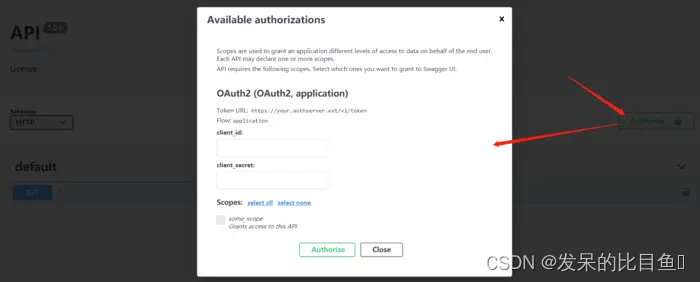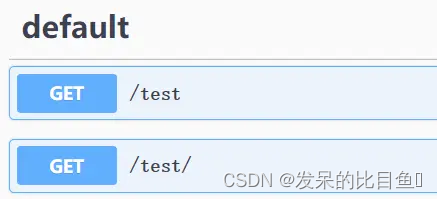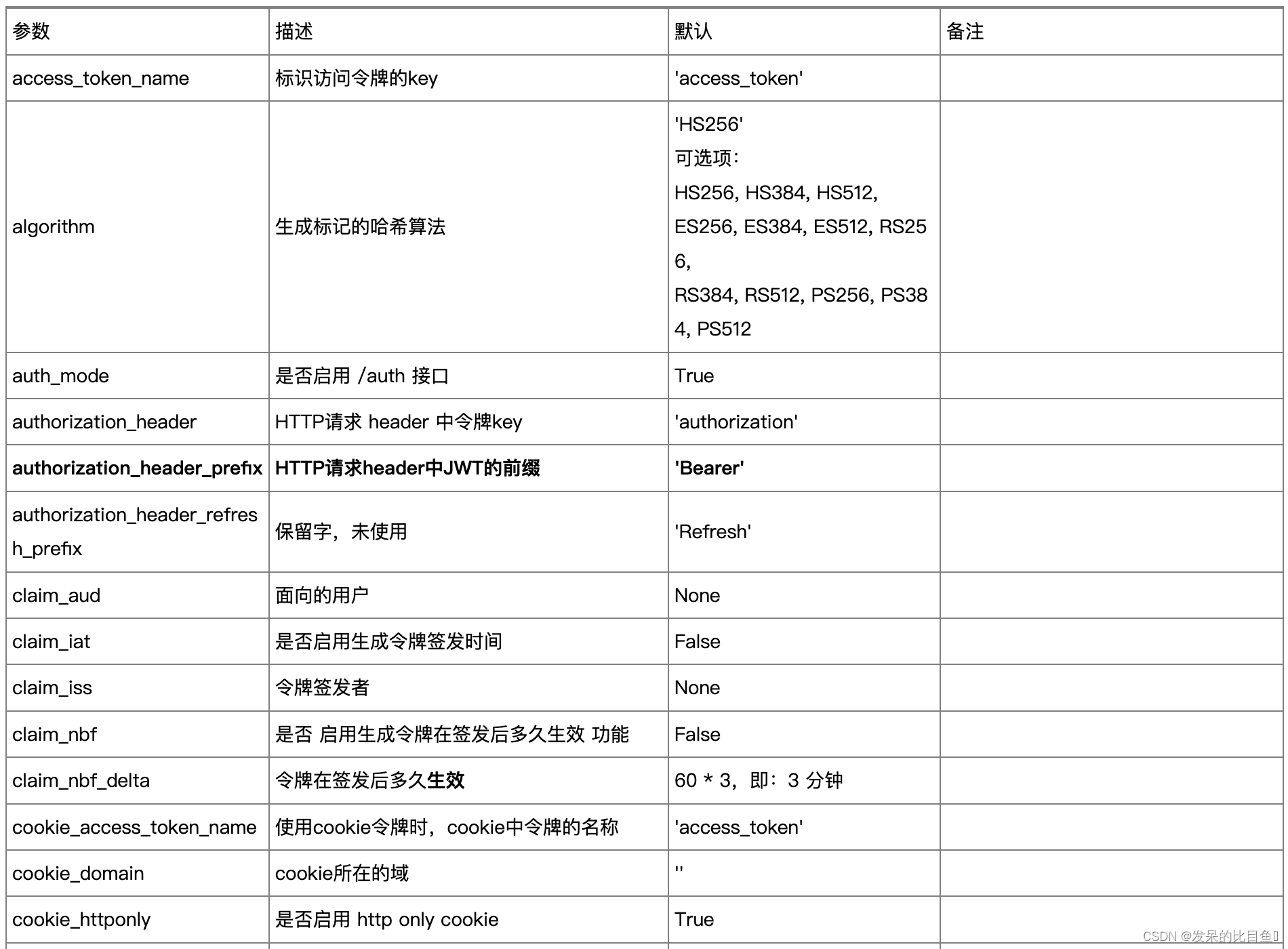sanic 教程
在Sanic的生命周期流程大致如下:
http请求——Sanic解析request——匹配路由——请求中间件——视图函数——响应中间件——http响应
依赖库
sanic==21.3.4
sanic-jwt==1.7.0
sanic-openapi==21.12.0
gunicorn==20.1.0
PyMySQL==1.0.2
aiomysql==0.1.1
DBUtils==1.3
依赖框架使用
sanic-openapi使用说明
1、设置文档title:API_TITLE


2、设置版本:API_VERSION


3、配置系统描述:API_DESCRIPTION


4、配置服务条款:API_TERMS_OF_SERVICE


5、配置邮件联系方式:API_CONTACT_EMAIL


6、配置许可证:API_LICENSE_NAME


7、配置许可证地址:API_LICENSE_URL


8、配置BASE_URL:API_HOST


9、配置接口统一的前缀:API_BASEPATH


也可单独配置


10、配置协议类型:API_SCHEMES


11、配置API必须通过身份验证进行访问:API_SECURITY、API_SECURITY_DEFINITIONS


12、配置API Key - in header


13、配置API Key - in query


14、配置OAuth2校验


15、配置是否展示接口末尾"/":API_URI_FILTER,默认不展示,slash展示,All则都展示




sanic-jwt使用说明
sanic-jwt 则是针对Sanic 开发的一个基于 PyJWT 封装的 JWT 授权认证模块。
Configuration 参数



代码
from sanic import Sanic, request, response
from sanic_jwt import initialize, Configuration, Responses, protected, exceptions, Authentication, inject_user
class User:
def __init__(self, uid, username, sex, password, info, black_level=0):
self.user_id = uid
self.sex = sex
self.username = username
self.password = password
self.personal_info = info # 只能登录后个人可见的信息
self.black_level = black_level # 黑名单等级,默认0为正常用户
def __repr__(self):
return "User(id='{}')".format(self.user_id)
def to_dict(self):
return {
"uid": self.user_id, # 注意:此处 "uid" 要与 MyJWTConfig 中的 user_id 设置一致!
"sex": self.sex,
"username": self.username,
"personal_info": self.personal_info
}
# 模拟一个用户列表
users = [
User(1, "user1", "男", "123", "这是仅 user1 可见信息", 1),
User(2, "user2", "女", "456", "这是仅 user2 可见信息", 0)
]
username_table = {u.username: u for u in users}
userid_table = {u.user_id: u for u in users}
async def authenticate(req: request.Request):
username = req.json.get("username", None)
password = req.json.get("password", None)
if not username or not password:
raise exceptions.AuthenticationFailed("用户名或密码为空!")
user = username_table.get(username, None)
if user is None:
raise exceptions.AuthenticationFailed("用户名或密码不正确!")
if password != user.password:
raise exceptions.AuthenticationFailed("用户名或密码不正确!")
return user
class MyJWTConfig(Configuration):
# -------------- url_prefix ---------------------
# [描述] 获取授权的路由地址
# [默认] '/auth'
url_prefix = '/login'
# -------------- secret -------------------------
# [描述] 加密密码
# [默认] 'This is a big secret. Shhhhh'
# [建议] 该密码是 JWT 的安全核心所在,需要保密,尽量使用更长更复杂的密码
# |secret = ',xxx'
# -------------- expiration_delta ----------------------
# [描述] 过期时间,单位为秒
# [默认] 30 分钟,即:60 * 30
# [建议] 该时间不宜过长,同时建议开启 refresh_token_enabled 以便自动更新 token
expiration_delta = 60 * 60 # 改为 10 分钟过期
# -------------- cookie_set ---------------------
# [描述] 是否将获取到的 token 信息写入到 cookie
# [默认] False,即不写入cookie
# 只有该项为 True,其它 cookie 相关设置才会起效。
# cookie_set = True
# -------------- cookie_access_token_name ---------------
# [描述] cookie 中存储 token 的名称。
# [默认] 'access_token'
# cookie_access_token_name = "token"
# -------------- cookie_access_token_name ---------------
# [描述] 包含用户 id 的用户对象的键或属性,这里对应 User 类的用户唯一标识
# [默认] 'user_id'
user_id = "uid"
claim_iat = True # 显示签发时间,JWT的默认保留字段,在 sanic-jwt 中默认不显示该项
class MyJWTAuthentication(Authentication):
# 从 payload 中解析用户信息,然后返回查找到的用户
# args[0]: request
# args[1]: payload
async def retrieve_user(self, *args, **kwargs):
user_id_attribute = self.config.user_id()
if not args or len(args) < 2 or user_id_attribute not in args[1]:
return {}
user_id = dict(args[1]).get(user_id_attribute)
# TODO: 根据项目实际情况进行修改
user = userid_table.get(user_id)
return user
# 拓展 payload
async def extend_payload(self, payload, *args, **kwargs):
# 可以获取 User 中的一些属性添加到 payload 中
# 注意:payload 信息是公开的,这里不要添加敏感信息
user_id_attribute = self.config.user_id()
user_id = payload.get(user_id_attribute)
# TODO: 根据项目实际情况进行修改
user: User = userid_table.get(user_id)
payload.update({'sex': user.sex}) # 比如添加性别属性
return payload
async def extract_payload(self, req, verify=True, *args, **kwargs):
return await super().extract_payload(req, verify)
class MyJWTResponse(Responses):
# 自定义发生异常的返回数据
@staticmethod
def exception_response(req: request.Request, exception: exceptions):
# sanic-jwt.exceptions 下面定义的异常类型:
# AuthenticationFailed
# MissingAuthorizationHeader
# MissingAuthorizationCookie
# InvalidAuthorizationHeader
# MissingRegisteredClaim
# Unauthorized
msg = str(exception)
if exception.status_code == 500:
msg = str(exception)
elif isinstance(exception, exceptions.AuthenticationFailed):
msg = str(exception)
else:
if "expired" in msg:
msg = "授权已失效,请重新登录!"
else:
msg = "未授权,请先登录!"
result = {
"status": exception.status_code,
"data": None,
"msg": msg
}
return response.json(result, status=exception.status_code)
app = Sanic("my_auth_app")
initialize(app, authenticate=authenticate,
authentication_class=MyJWTAuthentication, configuration_class=MyJWTConfig, responses_class=MyJWTResponse)
@app.route("/index")
@protected() # 保护该路由,只有授权用户才能访问
async def protected_route_index(req: request.Request):
# 从 request 中获取 payload,然后返回给前端
payload = await req.app.auth.extract_payload(req)
return response.json({'payloadInfo': payload})
@app.route("/info")
@inject_user() # 注入用户信息
@protected() # 保护该路由,只有授权用户才能访问
async def protected_route_info(req: request.Request, user: User):
if user.black_level == 0:
return response.json({'userName': user.username, "personalInfo": user.personal_info})
else: # 进入黑名单等级之后限制查看
return response.json({'userName': user.username, "personalInfo": ""})
if __name__ == "__main__":
app.run(host="0.0.0.0", port=8080, auto_reload=True)
参考
https://swagger.io/docs/open-source-tools/swagger-ui/usage/configuration/























 1183
1183











 被折叠的 条评论
为什么被折叠?
被折叠的 条评论
为什么被折叠?










